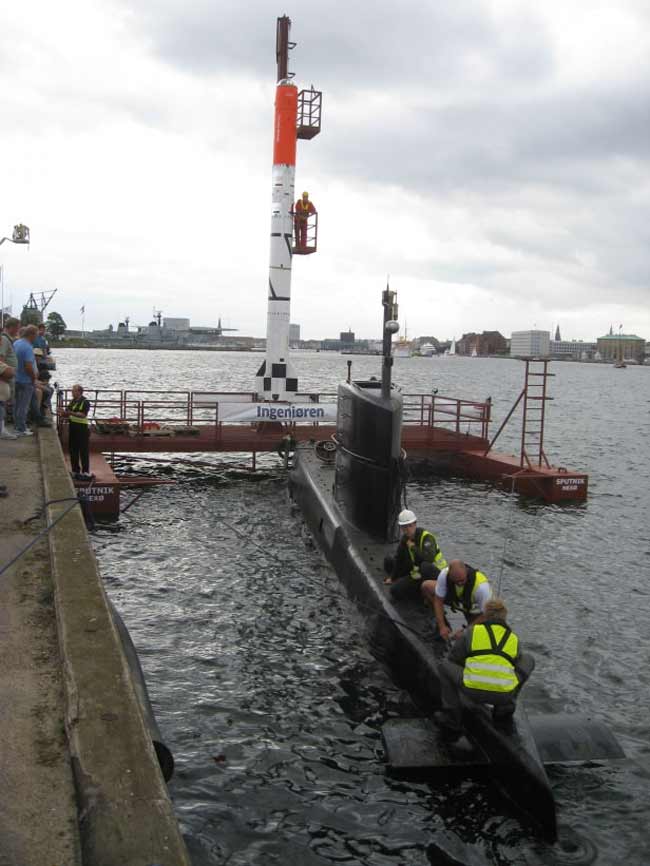Private Danish Rocket to Launch Mock Astronaut Tuesday

A private Danish rocket built by volunteers to launch oneperson into suborbital space is set to fly its first test flight Tuesday with adummy pilot riding aboard.
If successful, the rocket should carry its payload up almost19 miles (30 km) into the upper atmosphere. The project could pave the way forDenmark to eventually become the fourth space-faring nation to send humans intospace after Russia, the United States and China.
Tuesday marks the earliest launch date within a longerlaunch window that stretches from Aug. 30 to Sept. 17.
The new suborbital rocket is called the Hybrid ExoAtmospheric Transporter 1X, or HEAT-1X. It carries a Tycho Brahe space capsule,which can hold one pilot in a half-standing, half-sitting posture.?
But the rocket will just carry a dummy for the first severalsuborbital flights to see how much G-force a human would endure. One G isequivalent to Earth's standard gravity.
"We get three Gs half-sitting, half-standing,"said Peter Madsen, cofounder of Copenahgen Suborbitals. "Higher G loadsmay occur during re-entry, but here the capsule is oriented in a sidewardsposition where the astronaut has excellent G tolerance."
The $70,000 effort funded by private sponsorsand donations includes the capsule, booster and an offshore launch platform.
Breaking space news, the latest updates on rocket launches, skywatching events and more!
Madsen's homemade submarine from a pastproject, called the Nautilus, has the duty of towing the floating platform to adesignated launch site in the Baltic Sea near Copenhagen, Denmark. [10Private Spaceships Becoming Reality]
During the Tycho Brahe capsule's descent, adrogue parachute and three main parachutes should deploy and carry it back downfor recovery in the water by a fast boat.
Tracking radar and GPS should also help theground team keep an eye on the launch and return.
Making it all work
Madsen decided to kick-start the private rocket venture whenhe met Kristian von Bengtson, an aerospace engineer who has worked with NASA onMarsand lunar programs. They gathered a small group of about 19 supporting teammembers.
"We get a lot of support — and haveaccess to experts that would be very expensive if we were commercial,"Madsen told SPACE.com. "I honestly don't think we can afford to becommercial."
The Tycho Brahe capsule draws inspiration from the NASAspace capsules of the Mercury, Gemini and Apollo programs, von Bengtson wrotein an e-mail. But he also aimed to simplify the overall design.
Liquid oxygen serves as the oxidizer part ofthe propellant, and polyurethane acts as the rocket fuel propellant.That allows the HEAT-1X booster to burn for 60 seconds and create almost 9,000pounds of thrust (40 kN).
The inaugural flight should allow the Danish team to testthe offshore launch concept, the high-speed aerodynamic properties of thevehicle, engine performance and recovery scenarios. Wireless telemetry givesreal-time updates on the booster during burns.
A ride fit for astronauts
Sensors strapped to the dummy pilot can also record theforces that a living person might experience, for future design tweaks. ButMadsen and von Bengtson won't risk a human pilot until they feel confident inthe rocket's capabilities.
"We will need to see at least fourperfect flights — and if we feel it's needed we may even take more,"Madsen explained. "It's a cheap rocket with many reusable parts."
Future human pilots might require anastronaut-style spirit of adventure, considering that they have a 360-degreeview through the dome of plexiglass at the very tip of the rocket. They woulduse a joystick to control small cold gas thrusters that could rotate the craftaround for different views.
"Anybody flying a single personspacecraft is a true pilot-astronaut— and not a spaceflight participant," Madsen said. "This may appealto some."
An aerospike on top of the plexiglass shouldhopefully blunt the full shock and thermal effects acting on the dome, thedesigners said. The capsule also has an iron plate shell with a cork lining toserve as the heat shield.
The space experience
The strapped-in human pilot would have his orher arms free to operate manual override systems or grab a vomit bag or anadditional oxygen mask. The pilot would also have a pressure suit and a smallemergency parachute.
Many pilots may want to also carry a camera tosnap some pictures or capture video recordings. That should come inparticularly handy during the weightless apogee portion of the flight, whichwould last just over 90 seconds.
Madsen noted that Copenhagen Suborbitals wouldnever go commercial, but encouraged the idea of others picking up on theopen-source idea. The team's approach for cheap, manned spaceflight could alsopotentially fly faster and higher than any space plane concept, he added.
He also suggested one extra bonus that most private spaceflight companies won't offer —people could own their capsule and take it home as proof of their spaceadventures.
- Gallery: Liftoff! SpaceX's Falcon 9 Rocket's First Launch
- Top 10 Private Spaceships Becoming Reality
- SpaceX's Dragon Spacecraft Passes Big Drop Test
Jeremy Hsu is science writer based in New York City whose work has appeared in Scientific American, Discovery Magazine, Backchannel, Wired.com and IEEE Spectrum, among others. He joined the Space.com and Live Science teams in 2010 as a Senior Writer and is currently the Editor-in-Chief of Indicate Media. Jeremy studied history and sociology of science at the University of Pennsylvania, and earned a master's degree in journalism from the NYU Science, Health and Environmental Reporting Program. You can find Jeremy's latest project on Twitter.
